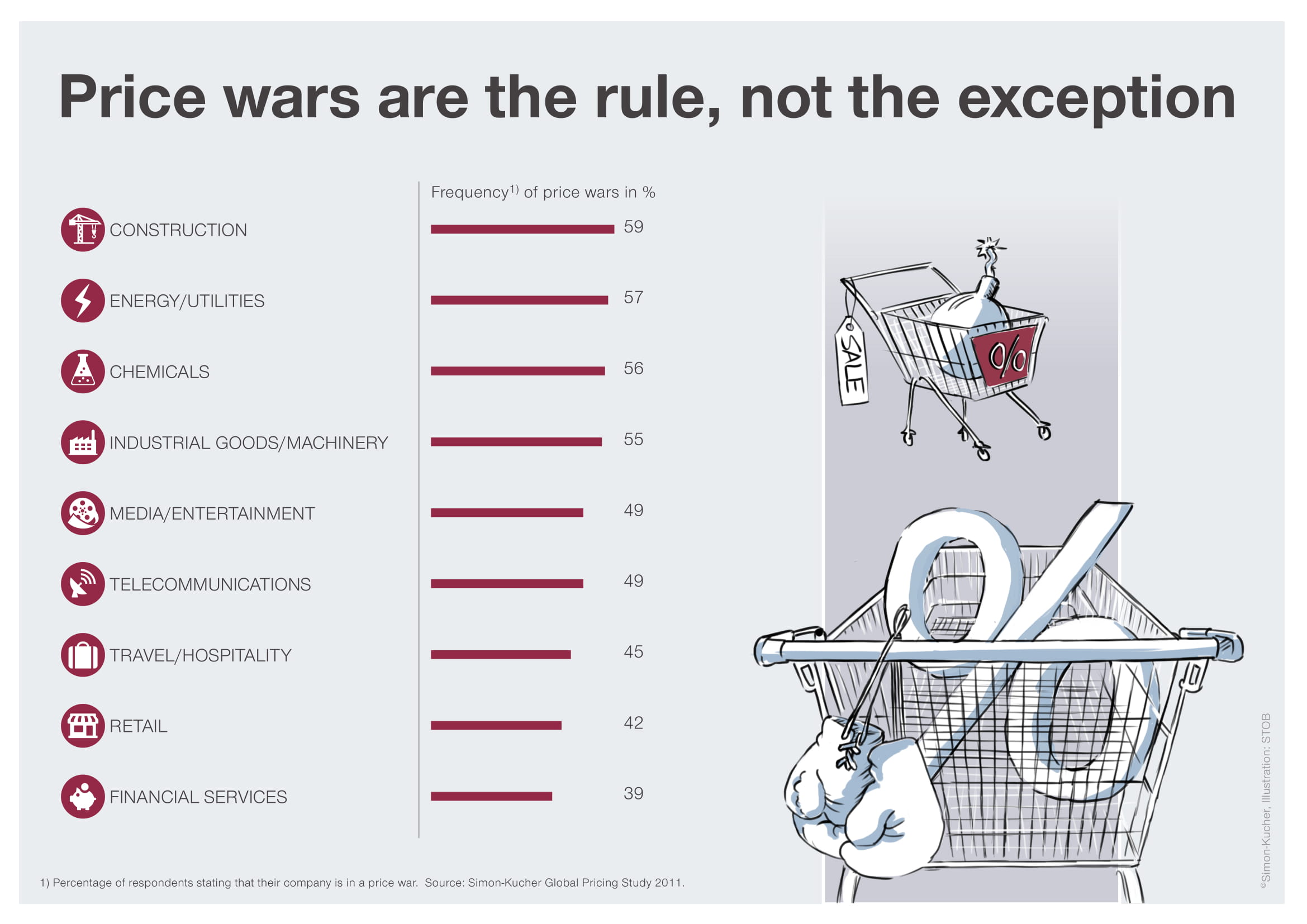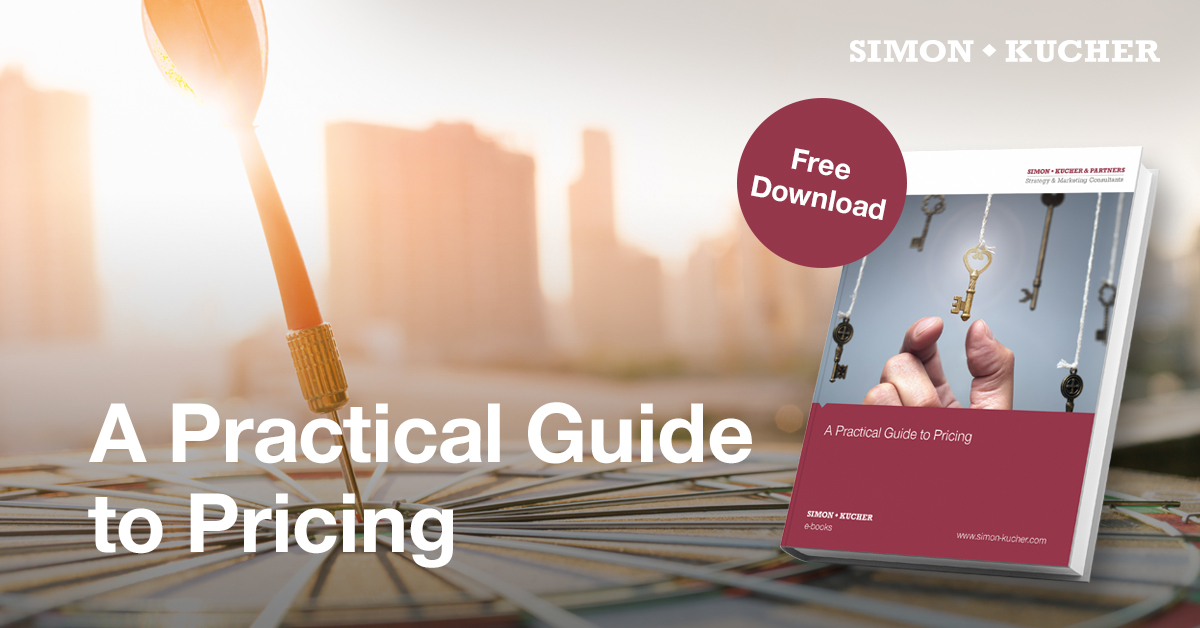More than half of all companies worldwide believe they’re involved in a price war. What do they have in common? Most think it’s not their fault and blame their competitors, but logically speaking, this can’t be true for everyone. Let’s look at why price wars flare up so quickly and what companies can do to avoid them.
Price wars sound dangerous, and they are – for everyone involved. They happen when companies in very competitive markets repeatedly lower their prices to get ahead of their competitors. Most of the time, their main goal is to increase their market share. However, not only do price wars fail to achieve this, they end up lowering companies’ profitability by causing margin pressure and value deterioration.
The free-for-all battle: Why do price wars start?
Why do companies find themselves participating in price wars time and time again? This can be due to several factors, but the primary reason is that managers think it’s always the other companies that initiate the combative behavior. They perceive these companies as price aggressive and are convinced their own company is reacting rationally to their competitors’ actions. The problem is that their competitors have the exact same mindset.
Several factors make markets particularly vulnerable to price wars, such as recurrent economic downturn, limited organic growth due to market saturation, and a high degree of price transparency combined with a very small number of large players that closely monitor each other’s prices.
Moreover, a price war is particularly likely to occur when consumers’ price awareness is high and switching costs are low, or when product differentiation is minimal causing consumers to consider price a key decision criterion.
Companies particularly vulnerable to price wars often:
- Offer commodity products
- Experience excess capacity
- Face new market entrants following penetration pricing strategies
- Need to keep sales volumes high to reduce average fixed costs per unit
We examined several cases of price wars and their causes. One example in the tobacco industry was sparked by a tax increase, which resulted in all brands except one raising their prices. When they subsequently lost market share, they lowered their prices again, initiating the price war. In the telco industry, a price war started when a new, aggressive player entered the market, causing established companies to reduce their prices significantly. In the end, the new player was forced to lower its own prices even more. Similarly, when the logistics sector experienced a sustained increase in fuel prices, big carriers reacted by increasing their airfares while discount carriers lowered theirs to win market share. Competitive pressure led larger carriers to reduce their prices as well, resulting in a lower price level than before.

Busting three myths about price wars
Companies that believe the following misconceptions can often end up in a disastrous situation:
- “A price war can be won”: In our experience, the only time one player comes out as the sole survivor in a price war is in newly emerging, mostly digital markets. In more mature markets, everybody loses
- “Significant market shares can be won”: Since all market players are trying to lure customers away from their competitors by constantly undercutting each other, customers may switch providers. However, this doesn’t result in a significant shift of market share. The battle for customers and the lowest prices simply continues
- “Market price level will recover”: Recovery only happens in rare cases and involves significant effort. In reality, prices hardly ever return to their pre-war levels
Escaping a price war
Okay, so you’ve gotten yourself in trouble and are stuck in a price war. What now? These steps will enable you to make it out of the danger zone in one piece:
- Change and adjust your mindset: You need to shift your focus away from price and volume toward value and profit. It’s also important to establish guidelines on how to react to competitors. You should always be on the lookout for competitors trying to halt the price war and then respond accordingly. Keep in mind the most beneficial outcome for everyone is to end the price war
- Develop a backup plan and a roadmap: To address your competitors’ actions effectively, develop a backup plan of possible surgical strikes and assess the biggest levers to manage reactions. Determine what your fair share is and decide which concessions on market share you’re willing to make. Then prepare a detailed roadmap for communication and product launches
- End your price aggression and implement your roadmap: You have to stop retaliating and start communicating a clear and consistent value story to the market. Focus on value, not price when launching new products
Following these guidelines will lead you back to healthy market development and competition.
Just don’t do it: Avoiding price wars
A much better and easier option is, of course, to never get into a price war in the first place. So how can you avoid them? Incorporate these three pillars to ensure your market development approach remains profitable and sustainable:
- Mindset: Create a culture of value rather than price-centricity. Take well thought-out steps rather than knee-jerk actions by performing a thorough risk assessment to avoid creating panic
- Preparation: Have clear rules and governance in place that specify how competitive moves should be countered. Identify what your red lines are and communicate these to the market
- Reconnaissance: Observe what your competitors are up to; assess strengths and weaknesses including behavioral aspects and be aware of the potential reactions you might trigger
Enjoyed reading our article? Good news: This popular series is available as A Practical Guide to Pricing! Download our free eBook now and learn how to achieve a sustainable, competitive advantage through pricing!
Read more from our expert blog series Pricing Basics:
Part 1: The Importance of Pricing
Part 2: Pricing Power, and How You Can Profit From It
Part 3: Why Prices End in 99… and Other Psychological Pricing Tactics
Part 4: Value Pricing Changes the Rules of the Game
Part 5: Digital Transformation – A New Way of Working
Part 6: Price increase? No problem. Preparation beats price pressure!
Part 8: Skimming or penetration pricing?









